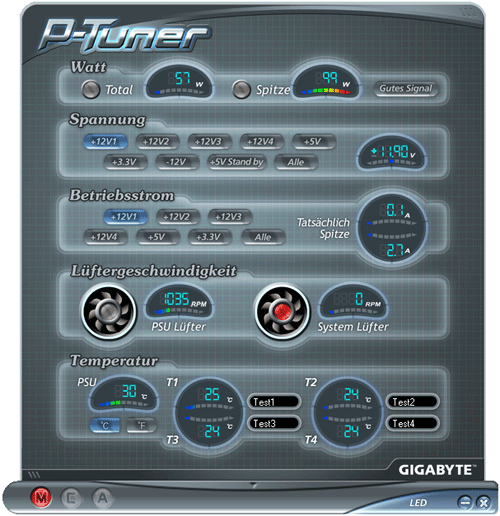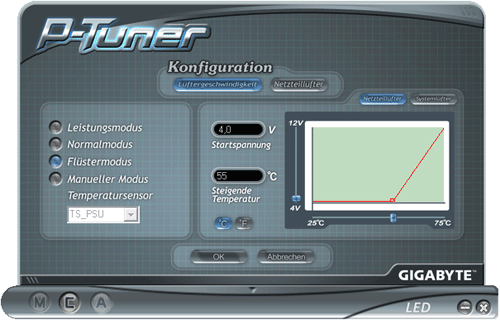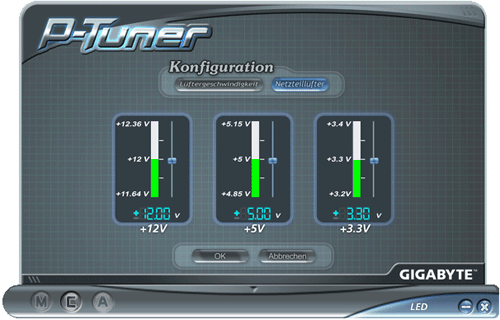Gigabyte's New Odin GT 800W Power Supply
by Christoph Katzer on July 24, 2007 12:01 AM EST- Posted in
- Cases/Cooling/PSUs
The P-Tuner Software, Cont'd

The fourth row with the two rotating fans shows the power supply fan on the left and the connected system fan on the right. We have double-checked the RPM with our equipment and were surprised about the high accuracy of this display.
The last row shows the temperature of the power supply itself and the four connected temperature diodes. To make things easier to remember, the user can name each sensor. Note also that the button to switch off the LEDs is located at the lower right side.

A very interesting area is marked with C on the bottom-left of the control-panel. Here you can actually control the power supply and the attached fans. In the top of the newly opened control are two submenus. The first one shows the control for the fans. You can use this to create your own scheme for how the fan should operate in your system. Caution should be exercised when using this utility, as you can force the fan to run very slowly at high temperatures. This can result in a very hot power supply which is certainly not good for any of the components inside and could easily lead to a PSU failure.

In our opinion, the most useful function of all is hidden under this second submenu. You can actually adjust the voltage supplied by the unit. OCZ was first in the market with this idea about four years ago with their PowerStream line of PSUs, but at that time we only got three potentiometers on the rear of the case, and you weren't given any clear indication of the result of any changes. You simply got a green light if the voltage was within spec or an amber light if it was out of spec. With this software you can regulate the output of the rails, and this should definitely be done since the default settings generate poor results as we saw during our tests. You can see the result of your changes immediately back in the main window so you can get the desired result.
To check how much we could adjust each rail we loaded this unit to its maximum of four times 15A on the 12V rails which is the maximum combined power. The 3.3V and 5V rails were also loaded to max. Running at its limit the rails all dropped below the ideal target values and we tried to use the software to regulate them back to normal. This resulted in the PSU switching off automatically. Remember: you can regulate the rails but there are limits to what you can accomplish.
Unfortunately, this kind of software doesn't come without problems. First of all we need to complain about the high CPU and memory load the software creates. With a typical midrange or better PC it would still be acceptable, but if you're running any demanding applications you might want to shut it off. Also, during the tests on the Chroma we connected the PSU to a second PC (which wasn't being powered by the PSU). While testing and changing to different tests the software always shut down and showed a connection problem with the PSU. This did not happen when the PSU and software were running in a normal PC configuration, but we did find it curious that the software apparently didn't like the results generated by Chroma.

The fourth row with the two rotating fans shows the power supply fan on the left and the connected system fan on the right. We have double-checked the RPM with our equipment and were surprised about the high accuracy of this display.
The last row shows the temperature of the power supply itself and the four connected temperature diodes. To make things easier to remember, the user can name each sensor. Note also that the button to switch off the LEDs is located at the lower right side.

A very interesting area is marked with C on the bottom-left of the control-panel. Here you can actually control the power supply and the attached fans. In the top of the newly opened control are two submenus. The first one shows the control for the fans. You can use this to create your own scheme for how the fan should operate in your system. Caution should be exercised when using this utility, as you can force the fan to run very slowly at high temperatures. This can result in a very hot power supply which is certainly not good for any of the components inside and could easily lead to a PSU failure.

In our opinion, the most useful function of all is hidden under this second submenu. You can actually adjust the voltage supplied by the unit. OCZ was first in the market with this idea about four years ago with their PowerStream line of PSUs, but at that time we only got three potentiometers on the rear of the case, and you weren't given any clear indication of the result of any changes. You simply got a green light if the voltage was within spec or an amber light if it was out of spec. With this software you can regulate the output of the rails, and this should definitely be done since the default settings generate poor results as we saw during our tests. You can see the result of your changes immediately back in the main window so you can get the desired result.
To check how much we could adjust each rail we loaded this unit to its maximum of four times 15A on the 12V rails which is the maximum combined power. The 3.3V and 5V rails were also loaded to max. Running at its limit the rails all dropped below the ideal target values and we tried to use the software to regulate them back to normal. This resulted in the PSU switching off automatically. Remember: you can regulate the rails but there are limits to what you can accomplish.
Unfortunately, this kind of software doesn't come without problems. First of all we need to complain about the high CPU and memory load the software creates. With a typical midrange or better PC it would still be acceptable, but if you're running any demanding applications you might want to shut it off. Also, during the tests on the Chroma we connected the PSU to a second PC (which wasn't being powered by the PSU). While testing and changing to different tests the software always shut down and showed a connection problem with the PSU. This did not happen when the PSU and software were running in a normal PC configuration, but we did find it curious that the software apparently didn't like the results generated by Chroma.










23 Comments
View All Comments
Gothik - Monday, January 7, 2008 - link
hi everyone,a noob here. I was wondering whether to get this PSU for my upcoming rig. I'm gonna run a quad core q6600, 4 sticks of ddr2 RAM, and a gf 8800GT (maybe SLI later). I was wondering, if the PSU is rated at 800w like the one being reviewed, does that mean that it is powered constantly at 800w or will the mechanism in the PSU determine the actual power consumed? Also, the author mentioned that there are a few PSUs that peform equally to this unit but cost less, can I know which ones are they?
Thanx.
QueBert - Monday, July 30, 2007 - link
about to buy a new PSU, want something future proof and modular. This looks about perfect for my needs. I find it odd that my Ultra X, which is years old and was the first Modular PSU. Still has better looking cables than any other modular unit on the market. Gigabyte seemed to step up the modular appearance a bit though. Kudos to them for that.wrong - Wednesday, July 25, 2007 - link
I can think of an excellent reason to honeycomb the side wall and put a sheet of plastic in to block airflow.Weight.
Not necessarily what they had in mind, of course. But LAN boxes should be light, and this could be one way to cut weight without reducing heatsink size and compromising cooling performance or noise.
I wonder if it makes a difference to EM noise.
Bozo Galora - Wednesday, July 25, 2007 - link
I really really like the way you do these PSU reviews. Much more informative indeed than anything else on the web. I am a bit dismayed over the way AT reviewers sugarcoat conclusions on obviously poor performing equipment - tho I understand why you have to do it.Now heres a review I would like to see......
There is a just out new Coolermaster MODULAR 1000W PSU with humungous rails
http://www.rbmods.com/Bilder/Articles/Coolermaster...">http://www.rbmods.com/Bilder/Articles/Coolermaster...
Heres the first review.......
http://www.rbmods.com/Articles/Coolermaster/Rs-a00...">http://www.rbmods.com/Articles/Coolermaster/Rs-a00...
This is the new esba model, NOT the current emba
Note in the review are the usual stupid useless graphs showing "rock solid" unchanging rails. Since I am about to buy, I would love to see how your review compares. And this is modular so it might help in your investigation of this modality.
Keep on truckin'
erikpurne - Tuesday, July 24, 2007 - link
Totally agree. It would be much easier to see where your system typically falls on the efficiency graph.
Also, on the 'Power Loss' graphs, the upper line should be input, and the lower one output. Oh, and watts are power, not energy!
Myrandex - Tuesday, July 24, 2007 - link
You should pictures of the LEDs, but there should have been a lights out LEDs enabled pic :)Good article though, and the build quality looked fantastic
the goat - Tuesday, July 24, 2007 - link
I assume that the software is only for windows? Of course the power supply will operate without the software but it would be nice to use the product to it's full potential with any operating system. In future articles please tell us if there is software for linux or not.Vidmar - Tuesday, July 24, 2007 - link
While I think the Efficiency charts in load percentage are nice, if you included Efficiency charts in watts it would be more informative from a buying perspective.The reason? I know the sum of system load is 375watts normally. The way it is now, if power supply XYZ has a max load of 650watts, I have to calculate where my ~375watts falls into that load chart (~57% load). But if the next power supply has 1000 watts max, then I have to yet again calculate what load percentage that may be for *that* power supply. If the Efficiency charts were in watts, instead of load, no calculations would be necessary. If I could look at your charts and see that XYZ power supply provided those watts the most efficiently, that would be the power supply I would get.
Maybe you could just provide a second X axis on the chart that included the watts.
Thanks!
MadBoris - Tuesday, July 24, 2007 - link
I really like the software component possibilities, looks like it needs some tweaking though like with 18a max per rail.As to memory and CPU usage, well that is .Net for you, that footprint problem is here to stay. Thx to MS.
I'm a little curious to the max 25a per rail.
Nvidia states 8800 GTX should have 30a http://nvidia.custhelp.com/cgi-bin/nvidia.cfg/php/...">Link
Maybe someone can clarify the real draw of an 8800 GTX and is 25a completely sufficient.
What about next gen?
Good review, looking forward to more like it.
As cool as this PSU is, $200+ is a bit too much for a PSU.
Christoph Katzer - Tuesday, July 24, 2007 - link
Depends on how much your graphics card needs to work. When your display just has 1024pxl in width you can run the 8800 in a decent system with a 300w psu. If you are using a 30" screen with 2560pxl in width it is a total different story. But don't worry, we are working on an article to make things like that very clear.